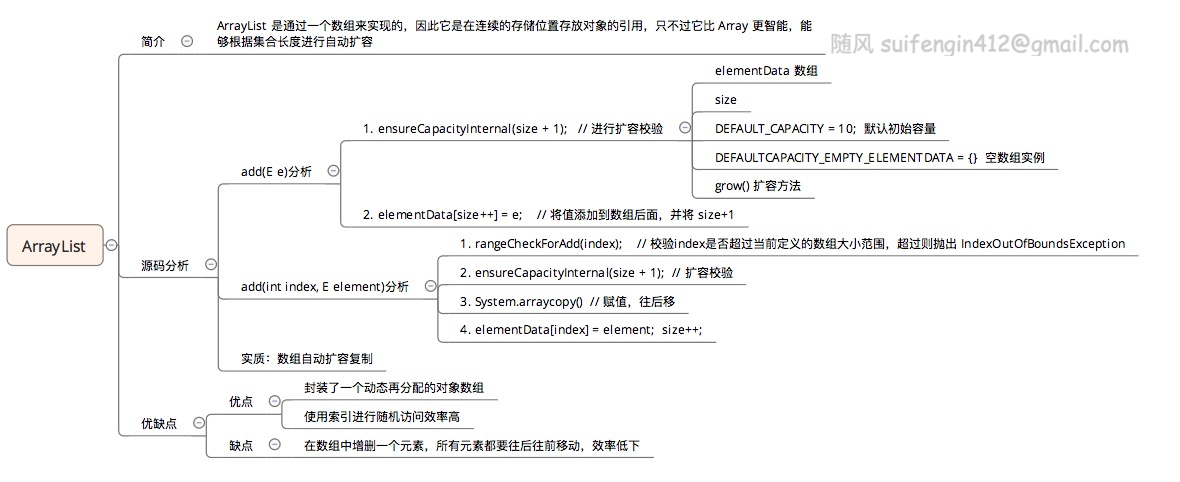- ubuntu12.04环境下使用kvm ioctl接口实现最简单的虚拟机
- Ubuntu 通过无线网络安装Ubuntu Server启动系统后连接无线网络的方法
- 在Ubuntu上搭建网桥的方法
- ubuntu 虚拟机上网方式及相关配置详解
CFSDN坚持开源创造价值,我们致力于搭建一个资源共享平台,让每一个IT人在这里找到属于你的精彩世界.
这篇CFSDN的博客文章Java 集合系列(二)ArrayList详解由作者收集整理,如果你对这篇文章有兴趣,记得点赞哟.
arraylist 。
arraylist 是通过一个数组来实现的,因此它是在连续的存储位置存放对象的引用,只不过它比 array 更智能,能够根据集合长度进行自动扩容.
假设让我们来实现一个简单的能够自动扩容的数组,我们最容易想到的点就是:
实际上,arraylist的内部实现原理也是这样子,我们可以来研究分析一下arraylist的源码 。
add(e e) 源码分析 。
|
1
2
3
4
5
6
7
8
9
10
11
12
13
14
15
16
17
18
19
20
21
22
23
24
25
26
27
28
29
30
31
32
33
34
35
36
37
38
39
40
41
42
43
44
45
46
47
48
49
50
51
52
53
54
55
56
57
|
/**
* appends the specified element to the end of this list.
*
* @param e element to be appended to this list
* @return <tt>true</tt> (as specified by {@link collection#add})
*/
public
boolean
add(e e) {
ensurecapacityinternal(size +
1
);
// 进行扩容校验
elementdata[size++] = e;
// 将值添加到数组后面,并将 size+1
return
true
;
}
/**
* the array buffer into which the elements of the arraylist are stored.
* the capacity of the arraylist is the length of this array buffer. any
* empty arraylist with elementdata == defaultcapacity_empty_elementdata
* will be expanded to default_capacity when the first element is added.
*/
transient
object[] elementdata;
// non-private to simplify nested class access
private
void
ensurecapacityinternal(
int
mincapacity) {
ensureexplicitcapacity(calculatecapacity(elementdata, mincapacity));
// elementdata 数组
}
/**
* default initial capacity.
*/
private
static
final
int
default_capacity =
10
;
/**
* shared empty array instance used for default sized empty instances. we
* distinguish this from empty_elementdata to know how much to inflate when
* first element is added.
*/
private
static
final
object[] defaultcapacity_empty_elementdata = {};
// 返回最大的 index
private
static
int
calculatecapacity(object[] elementdata,
int
mincapacity) {
if
(elementdata == defaultcapacity_empty_elementdata) {
// 与空数组实例对比
return
math.max(default_capacity, mincapacity);
}
return
mincapacity;
}
private
void
ensureexplicitcapacity(
int
mincapacity) {
modcount++;
// overflow-conscious code
if
(mincapacity - elementdata.length >
0
)
grow(mincapacity);
}
|
扩容调用方法,实际也就是数组复制的过程 。
|
1
2
3
4
5
6
7
8
9
10
11
12
13
14
15
16
17
|
/**
* increases the capacity to ensure that it can hold at least the
* number of elements specified by the minimum capacity argument.
*
* @param mincapacity the desired minimum capacity
*/
private
void
grow(
int
mincapacity) {
// overflow-conscious code
int
oldcapacity = elementdata.length;
int
newcapacity = oldcapacity + (oldcapacity >>
1
);
if
(newcapacity - mincapacity <
0
)
newcapacity = mincapacity;
if
(newcapacity - max_array_size >
0
)
newcapacity = hugecapacity(mincapacity);
// mincapacity is usually close to size, so this is a win:
elementdata = arrays.copyof(elementdata, newcapacity);
}
|
add(int index, e element) 源码分析 。
|
1
2
3
4
5
6
7
8
9
10
11
12
13
14
15
16
17
18
19
20
21
22
23
24
25
26
27
|
/**
* inserts the specified element at the specified position in this
* list. shifts the element currently at that position (if any) and
* any subsequent elements to the right (adds one to their indices).
*
* @param index index at which the specified element is to be inserted
* @param element element to be inserted
* @throws indexoutofboundsexception {@inheritdoc}
*/
public
void
add(
int
index, e element) {
rangecheckforadd(index);
// 校验index是否超过当前定义的数组大小范围,超过则抛出 indexoutofboundsexception
ensurecapacityinternal(size +
1
);
// increments modcount!!
system.arraycopy(elementdata, index, elementdata, index +
1
,
size - index);
// 复制,向后移动
elementdata[index] = element;
size++;
}
/**
* a version of rangecheck used by add and addall.
*/
private
void
rangecheckforadd(
int
index) {
if
(index > size || index <
0
)
throw
new
indexoutofboundsexception(outofboundsmsg(index));
}
|
从上面的源码分析可知,扩容和随机插入元素的消耗比较大,因此在实际开发中,应尽量指定arraylist大小,减少在随机插入操作.
优缺点 。
优点 。
缺陷 。
知识脑图 。

以上所述是小编给大家介绍的java集合系列arraylist详解整合,希望对大家有所帮助,如果大家有任何疑问请给我留言,小编会及时回复大家的。在此也非常感谢大家对我网站的支持! 。
原文链接:https://www.cnblogs.com/phpstudy2015-6/p/10618707.html 。
最后此篇关于Java 集合系列(二)ArrayList详解的文章就讲到这里了,如果你想了解更多关于Java 集合系列(二)ArrayList详解的内容请搜索CFSDN的文章或继续浏览相关文章,希望大家以后支持我的博客! 。
我正在编写一个具有以下签名的 Java 方法。 void Logger(Method method, Object[] args); 如果一个方法(例如 ABC() )调用此方法 Logger,它应该
我是 Java 新手。 我的问题是我的 Java 程序找不到我试图用作的图像文件一个 JButton。 (目前这段代码什么也没做,因为我只是得到了想要的外观第一的)。这是我的主课 代码: packag
好的,今天我在接受采访,我已经编写 Java 代码多年了。采访中说“Java 垃圾收集是一个棘手的问题,我有几个 friend 一直在努力弄清楚。你在这方面做得怎么样?”。她是想骗我吗?还是我的一生都
我的 friend 给了我一个谜语让我解开。它是这样的: There are 100 people. Each one of them, in his turn, does the following
如果我将使用 Java 5 代码的应用程序编译成字节码,生成的 .class 文件是否能够在 Java 1.4 下运行? 如果后者可以工作并且我正在尝试在我的 Java 1.4 应用程序中使用 Jav
有关于why Java doesn't support unsigned types的问题以及一些关于处理无符号类型的问题。我做了一些搜索,似乎 Scala 也不支持无符号数据类型。限制是Java和S
我只是想知道在一个 java 版本中生成的字节码是否可以在其他 java 版本上运行 最佳答案 通常,字节码无需修改即可在 较新 版本的 Java 上运行。它不会在旧版本上运行,除非您使用特殊参数 (
我有一个关于在命令提示符下执行 java 程序的基本问题。 在某些机器上我们需要指定 -cp 。 (类路径)同时执行java程序 (test为java文件名与.class文件存在于同一目录下) jav
我已经阅读 StackOverflow 有一段时间了,现在我才鼓起勇气提出问题。我今年 20 岁,目前在我的家乡(罗马尼亚克卢日-纳波卡)就读 IT 大学。足以介绍:D。 基本上,我有一家提供簿记应用
我有 public JSONObject parseXML(String xml) { JSONObject jsonObject = XML.toJSONObject(xml); r
我已经在 Java 中实现了带有动态类型的简单解释语言。不幸的是我遇到了以下问题。测试时如下代码: def main() { def ks = Map[[1, 2]].keySet()
一直提示输入 1 到 10 的数字 - 结果应将 st、rd、th 和 nd 添加到数字中。编写一个程序,提示用户输入 1 到 10 之间的任意整数,然后以序数形式显示该整数并附加后缀。 public
我有这个 DownloadFile.java 并按预期下载该文件: import java.io.*; import java.net.URL; public class DownloadFile {
我想在 GUI 上添加延迟。我放置了 2 个 for 循环,然后重新绘制了一个标签,但这 2 个 for 循环一个接一个地执行,并且标签被重新绘制到最后一个。 我能做什么? for(int i=0;
我正在对对象 Student 的列表项进行一些测试,但是我更喜欢在 java 类对象中创建硬编码列表,然后从那里提取数据,而不是连接到数据库并在结果集中选择记录。然而,自从我这样做以来已经很长时间了,
我知道对象创建分为三个部分: 声明 实例化 初始化 classA{} classB extends classA{} classA obj = new classB(1,1); 实例化 它必须使用
我有兴趣使用 GPRS 构建车辆跟踪系统。但是,我有一些问题要问以前做过此操作的人: GPRS 是最好的技术吗?人们意识到任何问题吗? 我计划使用 Java/Java EE - 有更好的技术吗? 如果
我可以通过递归方法反转数组,例如:数组={1,2,3,4,5} 数组结果={5,4,3,2,1}但我的结果是相同的数组,我不知道为什么,请帮助我。 public class Recursion { p
有这样的标准方式吗? 包括 Java源代码-测试代码- Ant 或 Maven联合单元持续集成(可能是巡航控制)ClearCase 版本控制工具部署到应用服务器 最后我希望有一个自动构建和集成环境。
我什至不知道这是否可能,我非常怀疑它是否可能,但如果可以,您能告诉我怎么做吗?我只是想知道如何从打印机打印一些文本。 有什么想法吗? 最佳答案 这里有更简单的事情。 import javax.swin

我是一名优秀的程序员,十分优秀!